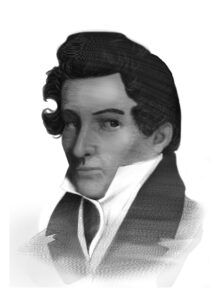Jarvis Frary Hanks
Drummer
11th U.S. Infantry
September 24, 1799 – June 27, 1853

Jarvis F. Hanks National Museum of the U.S. Army
Jarvis F. Hanks began his long career as an artist and a musician during his time in the Army. Sharing his experiences during the War of 1812 in his later memoirs, he reflected on his experience in the Army and the conditions that Soldiers endured. Thanks to his memoirs, Hanks offers a unique insight into the War of 1812.
Jarvis Frary Hanks was born in Pittsford, New York, in 1799 to Joseph and Anna Frary Hanks. At the age of four, he began attending a local school where his parents encouraged him in his studies. When Hanks was 11, his love of art and music grew. He requested to learn how to play the drums, so his father removed him from the nearby school and sent him to another town for drum lessons. He also took painting lessons from his uncle, David Frary.
In 1813, an Army officer visited Hanks’s hometown looking for recruits to fight in the War of 1812. Hanks was intrigued by the promise of “20 dollars bounty and 160 acres of land to anyone who enlisted five years or to the end of the war.” At the age of 14, Hanks enlisted as a drummer. In his memoir, he writes, “I was prepared to enter the Army, in the service of my country as a musician.” Drummers communicated with other units since drumbeats were loud enough to hear across the battlefield. They stood right behind the colors, or regimental flag, which put them into the direct line of fire. Hanks himself had several close calls while his regiment was under fire at the Battles of Chippewa and Lundy’s Lane, both fought in 1814.
During Hanks’s Army service, he wrote in a journal that his father gave him before he went off to war. Later in life, Hanks used this journal as the basis for his memoir and as a way to share his experience for “my own amusement, and for the perusal of a few friends.” In the memoir, he focused more on the camp atmosphere than on the battles he experienced. This was Hanks’s first time sleeping on “anything harder than feathers” and eating “any kind of meat unless it was previously well cooked.” His memoir offers a comprehensive look into the camp conditions of Soldiers during the War of 1812. On several occasions he notes that his unit ran out of provisions while on a march, which lower the Soldiers’ morale. He and other Soldiers ate raw pork with “greediness” and frequently slept in barns. Hanks’s mentions that these difficulties led numerous Soldiers in his unit to desert. One such deserter had to “run the gauntlet” in front of the unit and then serve five years of time doing hard labor at a camp. This served as a warning to other Soldiers of the harsh punishments that came with desertion.
As an artist, during the winter Hanks was responsible for drawing plans of fortifications, battle plans, cantonments, and harbors with his watercolors. Some officers saw his work and commissioned him to paint for them as well, paying him “a one dollar each.” Hanks chose not to reenlist and left the Army in 1815. His regimental commander gave him a letter saying he “faithfully performed all the duties of an excellent Drummer and Soldier.”
After the War of 1812, Hanks wanted to attend the United States Military Academy at West Point, but his father disapproved. Instead, he returned home to his family in Wheeling, in modern West Virginia. While there, he married Charlotte Garber and they spent a year there before moving to Ohio. Hanks became a well-known artist and opened a studio in Cleveland in 1835. He also traveled around the Midwest taking commissions for portraits.
Even though he initially longed for a military career, toward the end of his life Hanks reflected that he was grateful for his father’s decision for him to leave the Army because he was able to dedicate his life to art. Hanks also continued to play music throughout his life and became an accomplished fiddler. He even gave voice and music lessons to children. With 10 children himself, he worked with local families, giving them the opportunity to learn different art forms such as music and painting. Hanks also participated in various community organizations. As an avid abolitionist, he joined the Cleveland Anti-Slavery Society and later become its secretary. In 1850, Hanks served as music director of the new Cleveland Mendelssohn Society. After a long career of working in his community, Hanks died at the age of 54 on June 27, 1853, after suffering from tuberculosis. He is buried in the Woodland Cemetery in Cleveland close to where his family was living.
Ellora Larsen
Education Specialist
Sources
Grant, Francis. “Hanks, Jarvis Frary.” The Encyclopedia of Cleveland History. Last modified July 17, 1997. http://ech-dev.case.edu/cgi/article.pl?id=HJF.
Grant, Francis. “Hanks, Jarvis Frary.” Case Western Reserve University. Accessed December 7, 2021.. https://case.edu/ech/articles/h/hanks-jarvis-frary.
“Jarvis F. Hanks.” Ohio History Central. Accessed September 17, 2021. https://ohiohistorycentral.org/w/Jarvis_F._Hanks.
Hanks, Jarvis. “The Memoirs of Jarvis Hanks.” The Patriot Files. Accessed September 17, 2021. http://www.patriotfiles.com/index.php?name=News&file=article&sid=102.
Hanks, Jarvis Frary. “Drummer Boy!” The War of 1812 Memoir of Private Jarvis Frary Hanks, 11th Infantry 1813-1815. Buffalo, NY, 18311.
Additional Information
“The Battle of Chippewa.” Center of Military History. Accessed December 7, 2021. https://history.army.mil/html/artphoto/pripos/usaia-print/chippewa-p.html
“Chippewa, 5 July 1814.” Center of Military History. Accessed December 7, 2021. https://history.army.mil/html/reference/army_flag/1812.html#chippewa
